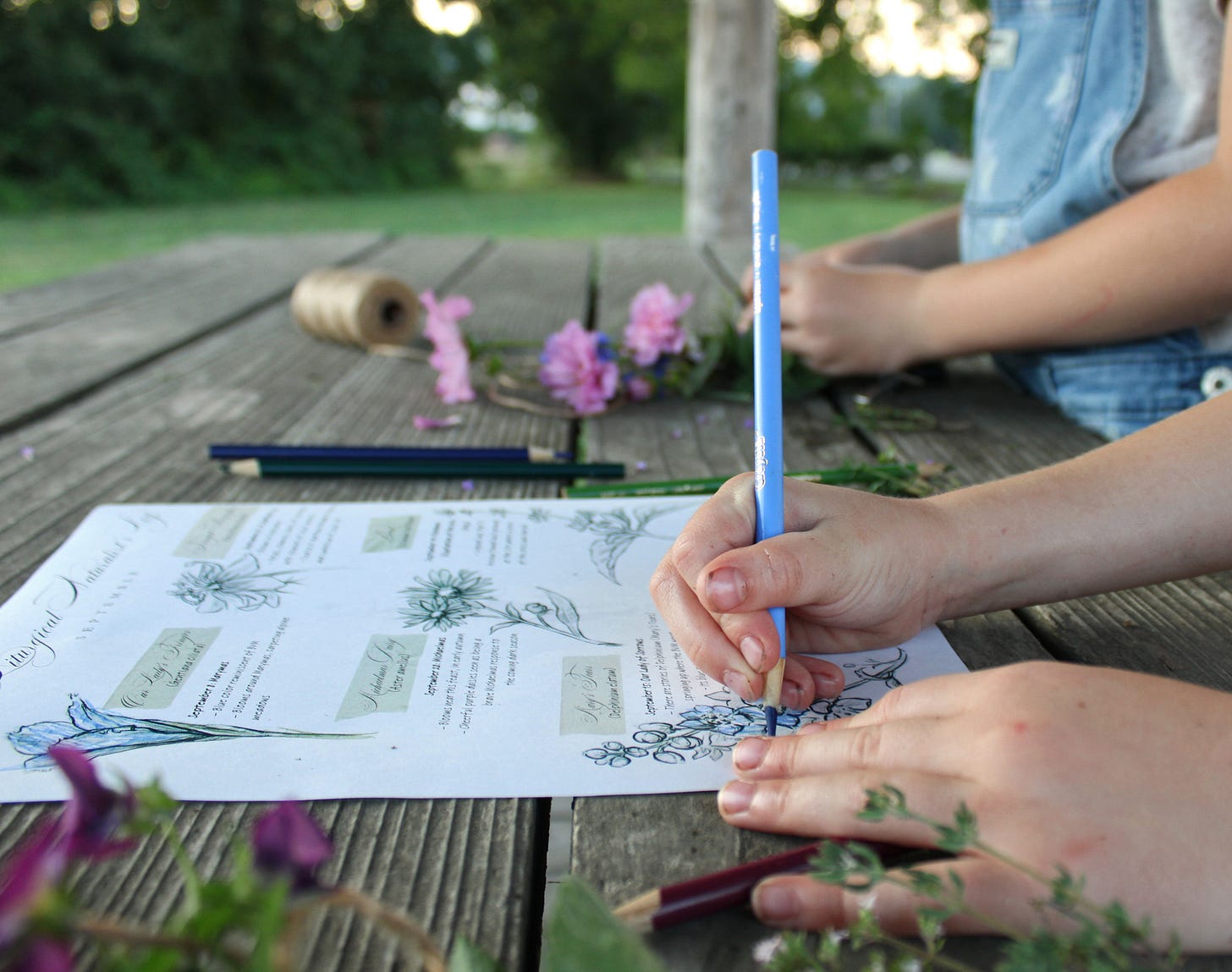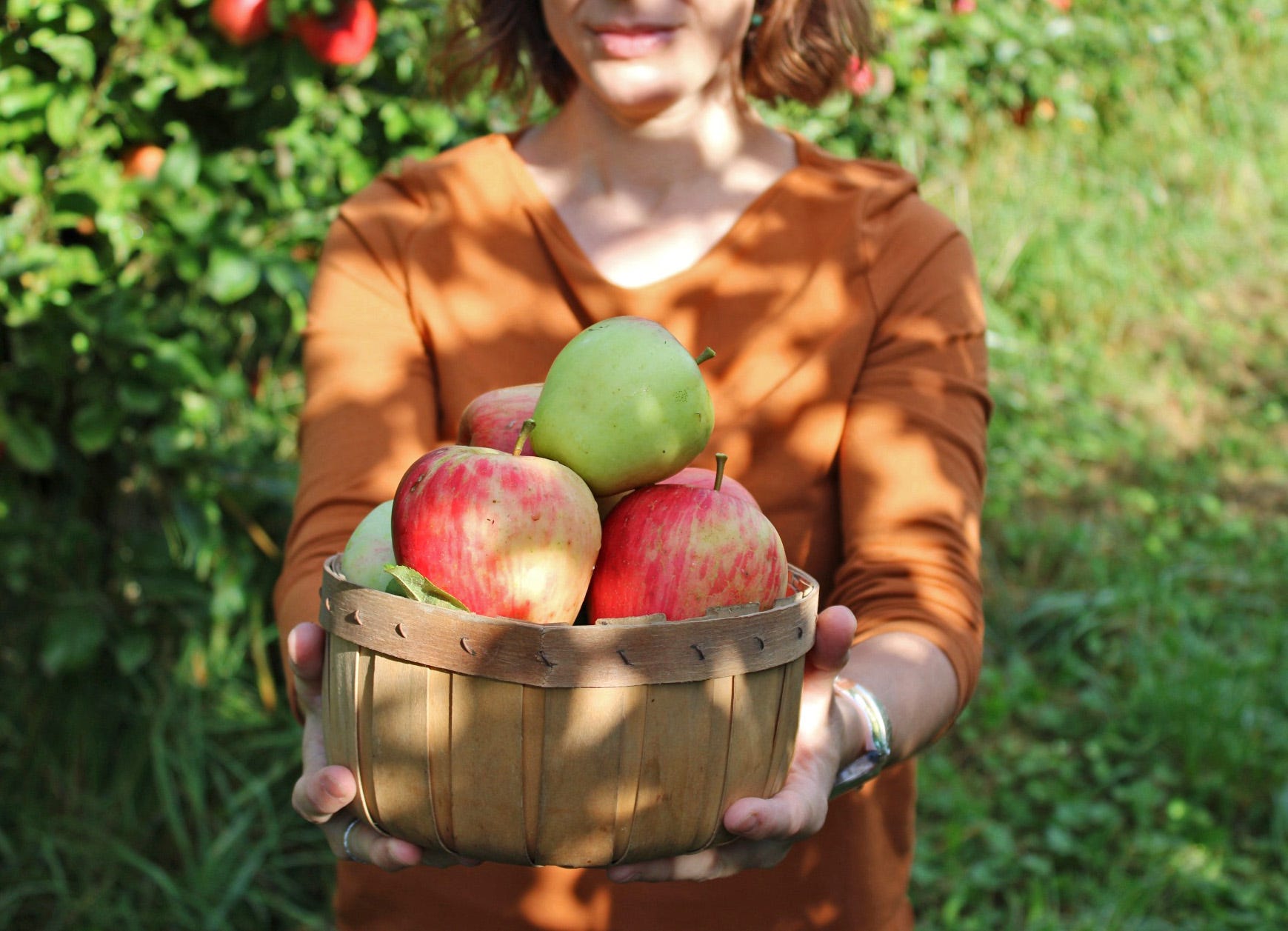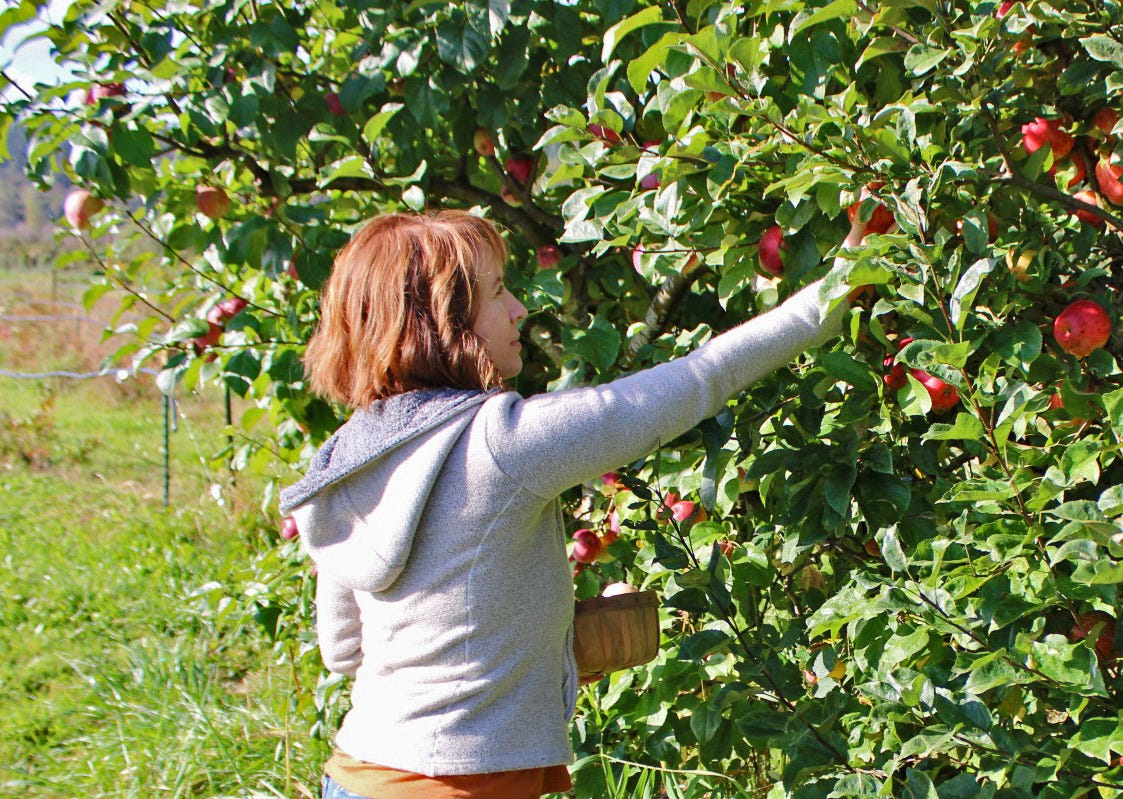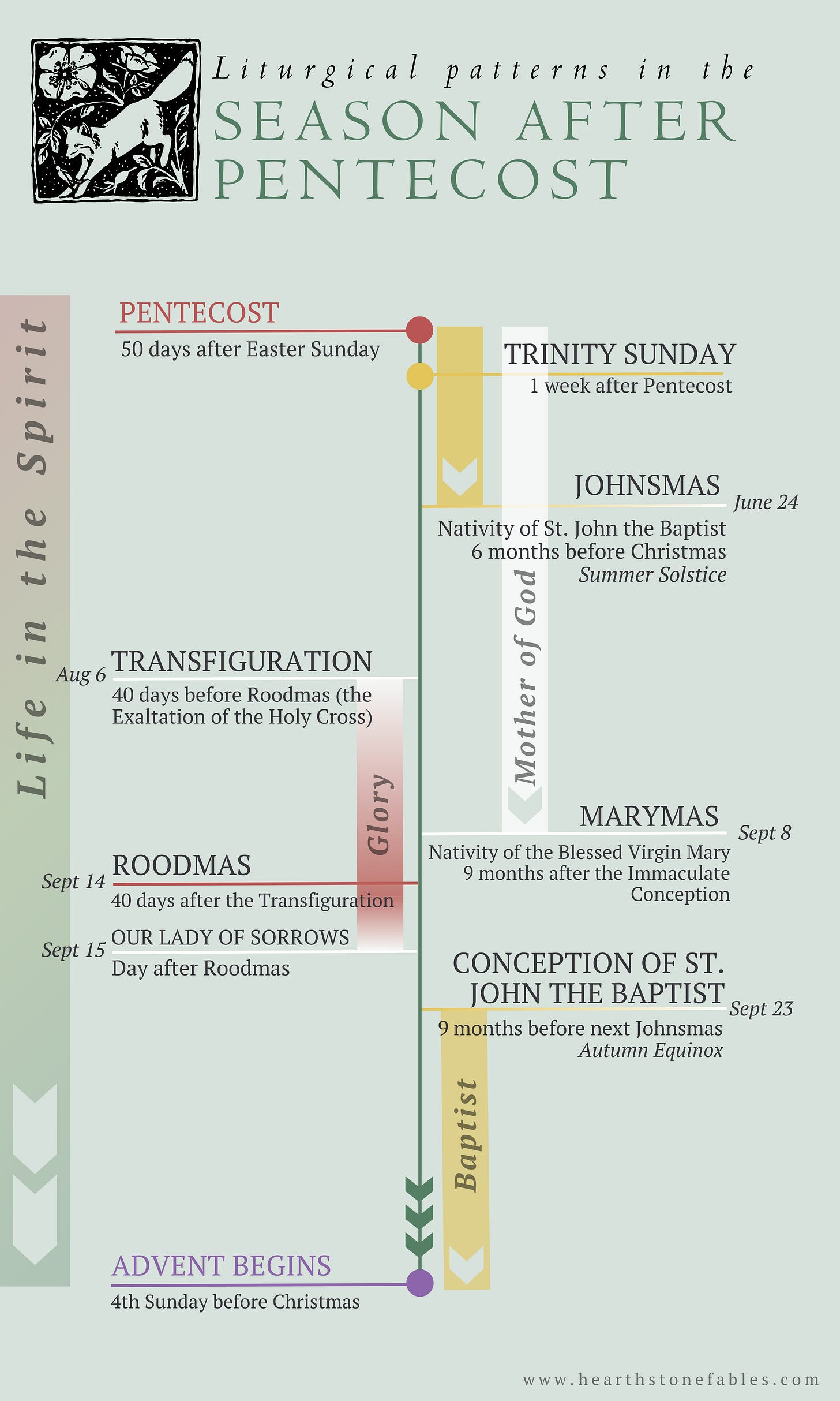The patterns within Ordinary Time II
Finding the shape of this longest of Church seasons
“The mystery of our sanctification in Christ is, then, that the love of God, the bond of the Father and the Son, the Holy Spirit, reaches out to us from within Christ, and brings to life divine love, the likeness of Christ in us. He makes Christ live in us when the love that comes to us from Christ becomes our love and remains in us while it also remains in Him. This same love, this same Spirit, unites us all to one another in Christ.”
Thomas Merton, Seasons of Celebration
Welcome! Whether you’re a longtime friend or a new kindred spirit here (I recommend visiting the Village Green to get your bearings), I’m delighted to be a companion to you through the liturgical year.
Pax+bonum, Kristin.
Here we are in September, with leaves turning and pumpkins starting to orange up - and, liturgically, we’re still in Ordinary Time II. This season is so long that we find ourselves starting it with hopeful hunts for ripe strawberries, each day lengthening in sunlight and warmth - and we move through that whole summertime, right into fall days with warm soups and cozy sweaters.
It can feel overwhelming, and it’s easy to get caught in the doldrums of that overwhelm: summertime days passing in a successive blur, without some of our favorite high feasts like Christmas or Easter to punctuate them, can leave us unmoored.
But…what if I told you that Ordinary Time II - this huge stretch of time between the end of Easter and the beginning of Advent - is actually my favorite liturgical season?
Church and denominational web sites often describe it as being outside the “major” seasons, which, of course, implies that it’s minor. This tends to add to that doldrums feeling that OTII can bring.
Honestly, I beg to differ…this season of Ordinary Time II is the fruition of Christmas and Easter, which is no small thing. It fits into the rest of the calendar in a profound way and can be one of the richest liturgical seasons once we start to see its shape.
Paid Members: If you haven’t printed them out yet, hop over to the Scriptorium to find your first batch of Ordinary Time II printables for your liturgical year binders!


WHAT IS ORDINARY TIME II?
Ordinary Time I (Season After Epiphany) begins on the Monday after the Baptism of the Lord (the Sunday following Epiphany) and ends on the Tuesday before Ash Wednesday.
Ordinary Time II (Season After Pentecost) begins on the Monday after Pentecost Sunday and ends the day before the first Sunday of Advent. In some traditions, OTII begins on Trinity Sunday (the Sunday after Pentecost).
(I know…it sounds like a tongue-twister. Because it is.)
As I’ve written about earlier, the liturgical year is incredibly flexible and local at its core: the calendar, as we receive it today, has gone through innumerable changes. And it will continue to change.
What we receive today as Ordinary Time II has traditionally been called the Season After Pentecost. Its winter counterpart - Ordinary Time I - was, likewise, called the Season After Epiphany (or, even further back in history, the Season After Theophany). Those names still remain in some traditions, but they are often being blended more toward the blanket of “Ordinary Time.”
Where the Season After Epiphany and Season After Pentecost were once more distinct, they have been joined into two expressions of one encompassing season of Ordinary Time.
This shift happened recently: in the liturgical reforms of the 1960s (with Vatican II and the ecumenical adoption of the Revised Common Lectionary), these two distinct seasons - After Epiphany and After Pentecost - were placed under the umbrella and title of Ordinary Time: tempus per annum, or ‘time through the year.’ As you’ve probably read before, “Ordinary” is not meant to indicate plain-ness or unimportance: rather, it refers to the counting of time, the succession of days.
While this unification of two seasons has a lot of beauty in it, we’re also losing important context when we approach Ordinary Time II: we forget that it is Pentecost-tide. A season infused with the fire of the Holy Spirit: a time informed by the wholeness of the Trinity! (How can we possibly imagine this season as anything but ‘major’ when we have that context in mind?!)
The trouble is that we’ve lost the shape of it. Ordinary Time II often feels blurry, foggy. The feasts that were once cultural cornerstones are now more obscure and less pervasive. It can feel like a waiting room between Easter and Advent.
But, my friends, it’s SO MUCH MORE!
THE SHAPE OF A TRINITARIAN SEASON
In the high feasts of Easter and Christmas1, we’ve retained much of their surrounding liturgical, seasonal context: we see the way each is prefaced by a fast, enjoys its own season of celebration, and impacts the layout of related holy days…all of this deepening our journey through the life of Christ.
It’s easy to treat the liturgical calendar as a succession of events, though - a linear movement through time, checking off boxes as we go and then moving on to the next holy day or season.
But the Church year is a layered mystery. Each holy day is like a pebble dropped into a pond, its ripples emanating outward in all directions, intersecting and influencing all the other movement.
As we move through time in the liturgical calendar, we accumulate more mystery, more depth, more devotion: Advent, the opening of our year, does not cease to be once Christmas arrives. It stays with us, imbuing each passing season and holiday with Adventide wisdom for us to harvest.
And, though Ordinary Time II - our Season After Pentecost - hasn’t retained its liturgical context in the same way other seasons have, we can start to trace out some shapes within it, helping to tether it to the rest of the Church calendar and to illuminate how incredibly festive this season truly is.
Every single holy day in the calendar, whether feast or fast, shimmers with a different angle of the same holy reality of salvation.
When we step back to see how these holidays tell the story of Christ’s redemptive work together, though, we can find patterns that flavor and enliven the season in which they dwell.
(It reminds me of when, under the night sky, I start to draw my focus back…revealing constellations that tell whole stories, each made of glimmering stars).
In Ordinary Time II, a season of faithful growth in Christ, we practice life in Pentecost-tide: enfleshed by the lived reality of the Trinity, enlivened with the Holy Spirit, and sent forth into our places - as well as into the depths of our own souls.
Amidst all the transformational Saint days that tell this story throughout OTII, we also find expressions of theology & faith that are tethered to other moments in the ritual year.
ORDINARY TIME II PATTERNS
A VOICE IN THE WILDERNESS:
As we enter OTII, we approach the Nativity of St. John the Baptist on June 24…affixed to the Summer Solstice. John is our perennial voice in the wilderness, reminding us to straighten our paths for the Christ, and his Nativity is tethered to Christmas: John is six months older than his cousin Jesus, and the calendar’s storytelling wisdom thus places his birthday at Midsummer. What a tangibile mirror for our Midwinter Christmas miracles: in ritual time, John comes to us at the fulcrum of the sun’s movement…just as he predicted that he would decrease, and Christ would increase.2 In our Summertime OTII, he points the way to Jesus.
As we move toward Autumnal OTII, though, we revisit John…the calendar begins the annual rotation of his story yet again, giving us the feast of the Conception of St. John the Baptist on September 23. Its date is, again, determined by our fixed date of Christmas; it’s also, as a result, tied to the Autumn Equinox, when day and night are equal, and we begin that descent into darkening days.“And you will have joy and gladness, and many will rejoice at his birth, for [John] will be great before the Lord. And he must not drink wine or strong drink, and he will be filled with the Holy Spirit, even from his mother’s womb.”
Luke 1:14-15 ESVHere, in our Spirit-filled season informed by Pentecost and the Trinity, the calendar gives us the desert prophet who lives on wild honey and baptizes the Son of God: will we truly let our days be baptized, will we straighten our paths as we walk in this gift of the Holy Spirit?
MOTHER OF GOD:
Likewise, just as we approach the Baptist’s birthday in OTII, we also receive the Blessed Virgin Mary’s nativity in autumn on September 8: Marymas. (Isn’t that remarkable to notice, friends? Of only three nativities in the Church year, two of them are celebrated during Ordinary Time II…one in the summer, one in the fall).
Mary’s Nativity in early September reaches back to the the feast of her conception, on December 8, linking the wintry beginning of Mary’s life with her birth at the height of harvest season.“The Holy Spirit will come upon you, and the power of the Most High will overshadow you; therefore the child to be born will be called holy— the Son of God.”
Luke 1:35 ESVMother to us all, we get to spend the first half of Ordinary Time II celebrating the fruitful growth of the season alongside the ripening, and then birth, of Mary: the Blessed Virgin who so completely embodied God’s will, despite the cost she would bear. Are we, like Mary, willing to receive the movement of the Holy Spirit (that most spritely figure of God’s personhood), amidst all the trials?
GLORY:
In August, we begin a poignant journey that weaves together suffering and triumph: on August 6, we celebrate the Transfiguration. And, forty days after that glorious shining moment, we mark the Feast of the Exaltation of the Holy Cross. The calendar takes us from a revelation of the full glory of Christ’s nature to his tortured death on a Cross…and, somehow, glory imbues it all.
Bridging that space between full glory and absolute suffering is our familiar language of 40 days…an echo of Jesus’ 40 days in the desert, of our 40 days spent fasting in Lent.“And Jesus, full of the Holy Spirit, returned from the Jordan and was led by the Spirit in the wilderness for forty days, being tempted by the devil.”
Luke 4:1-2 ESV
“…a cloud came and overshadowed them, and they were afraid as they entered the cloud. And a voice came out of the cloud, saying, ‘This is my Son, my Chosen One; listen to him!’”
Luke 9:34-35 ESV
“For Christ also suffered once for sins, the righteous for the unrighteous, that he might bring us to God, being put to death in the flesh but made alive in the spirit…”
1 Peter 3:18 ESVSometimes the Spirit leads us to the desert. We go from shining mountaintops to the Cross, then back again…with long stretches of the arid in between.
And striking through it all is the cord of glory, gift of the salvific work of Christ. Glory in the joys, glory in the suffering, glory when the Spirit calls us to wander through the desert.
So…will I bend to the Spirit’s movement? I sure don’t want to willingly enter the deserts of life…but a what a balm we have in the recollection that we are indwelt with the Holy Spirit, that Christ is the revelation of God’s character, in which we can always trust no matter the circumstances.“We have to trust that the transfiguration experience is closer to us than we might think. Trusting that, we may also be able to live our Gethsemane experience without losing our faith.”
Fr. Henri Nouwen, Eternal Seasons (edited by Michael Ford)
BENEDICTION
The Spirit of God
is a life that bestows life,
root of world-tree
and wind in its boughs.Scrubbing out sin,
she rubs oil into wounds.
She is glistening life
alluring all praise,
all-awakening,
all-resurrecting.St. Hildegard von Bingen, Antiphon for the Holy Spirit (translated by Barbara Newman)
What has your experience of Ordinary Time been like? Do you have favorite feasts or traditions during this special season, or does it seem a bit overwhelming to approach? Either way, I hope that you can find ways to linger in these Trinitytide days, savoring the beautiful, complicated glory they bring.
Pax et bonum,
Kristin
READ ON
For instance: the fixed date of Christmas, on December 25, is the point from which Nativity feasts and fasts emanate: from preparatory Advent, to the feast of the Purification (Candlemas), to the date of the Annunciation and conception of the Christ. All of these holy days interact with the movable date of Easter and its associated fasts and traditions, making for a vibrant re-living of these crucial moments in God’s story and in our story as creatures.
“He must increase, but I must decrease.” (John 3:30 ESV)
















As always, this is so beautiful! We’re with the Ordinariate, who counts this entire season as Trinitytide. For instance, this is the 15th week of Trinitytide. I love it.
I am looking forward to you explaining the reason for the owl holding a radish. This is clearly the time when a picture is worth a 1000 words. 🌸